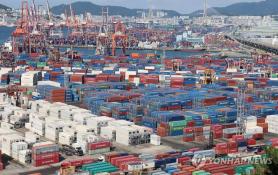
SEOUL, November 24 (AJP) - The Korean won’s slide toward the 1,500-per-dollar mark — a level touched only during crisis periods — is raising alarms for a trade-dependent economy where a cheaper currency now delivers diminishing benefits to exports while magnifying cost burdens for companies with massive U.S. investment plans.
According to Bank for International Settlements data, Korea’s real effective exchange rate (REER) fell to 89.09 at the end of October, the lowest since August 2009. A REER below 100 signals an undervalued currency, and the index is expected to drop further for November after the dollar gained more than 3 percent over the past month.
FX dynamics no longer guarantee an export lift
In past cycles, a weaker won reliably boosted Korean exporters by enhancing price competitiveness against Japanese and European rivals. Today, the equation is more complicated. A disproportionately weak currency can distort costs, compress margins, and aggravate balance-sheet stress — especially for conglomerates juggling multi-billion-dollar commitments tied to the $350 billion U.S. investment package negotiated as part of the tariff deal.
Economists say the latest bout of weakness reflects both global and domestic factors.
“The dollar is strong everywhere, but the won has weakened more sharply than peers like the yen,” said Jang Bo-sung, research fellow at the Korea Capital Market Institute. He cited Korea’s surge in overseas equity investment and exporters’ reluctance to convert dollar-denominated proceeds as key reasons for the tight FX supply. “This looks more like a supply–demand imbalance than a structural collapse,” he said, suggesting the slide is driven more by near-term flows than a long-term depreciation trend.
Chipmakers: higher dollar revenue, higher dollar costs
A strong dollar carries mixed implications for semiconductor firms, which account for a quarter of Korea’s exports and derive significant revenue from the U.S. — an estimated 70 percent for SK hynix. While a stronger dollar lifts reported earnings, it also raises import costs for materials, equipment, and R&D inputs, limiting net benefits.
“Semiconductors and shipbuilding are industrial goods with lower FX sensitivity than consumer products,” Jang noted. “The export boost from a weaker won is far smaller today than in the 2000s.”
Adding to the strain, Korean chip, battery, and auto makers are locked into major U.S. factory builds. A strong dollar inflates the won-denominated cost of these projects: LG Energy Solution’s Arizona plant, initially estimated at $3.2 billion when the rate was 1,305 won per dollar, now faces more than 10 percent higher local-currency costs.
Aviation and import-heavy sectors face direct cost shock
Industries that rely heavily on dollar-denominated inputs are among the most exposed. Airlines pay for jet fuel, aircraft leases, and many maintenance contracts in dollars, meaning every notch lower in the won widens their cost base. Even with recovering passenger demand, carriers risk margin compression unless they raise fares or cut capacity — decisions that could cool travel demand.
Import-dependent sectors such as petrochemicals, cement (due to coal), and start-ups conducting overseas clinical trials also face disproportionate pain, as they cannot avoid dollar-priced inputs while global demand remains weak.
The old rule of FX-driven export gains is fading
The traditional rule of thumb — a weaker won automatically boosts export champions — has weakened. Korea’s conglomerates increasingly produce goods in overseas factories and sell them in local currencies, while hedging more aggressively to smooth volatility. As a result, the pass-through from FX weakness to export volume has diminished, while the inflationary impact of pricier imports has intensified at home.
“Exports today benefit less from FX than they used to, while import costs feed into domestic inflation much more quickly,” Jang said.
A 1,500 won level is now more balance-sheet stress test than export windfall
Going forward, the won’s trajectory will hinge on Korea–U.S. interest-rate differentials, foreign capital flows, and the country’s trade balance. Research from the Korea Capital Market Institute shows that the exchange-rate effect on Korea’s exports has markedly weakened since the early 2010s as manufacturers expanded offshore production and moved deeper into global value chains.
A near-1,500 won level, once considered an export advantage, now functions more as a stress test for corporate balance sheets and investment plans than a simple tailwind for competitiveness.
Copyright ⓒ Aju Press All rights reserved.




